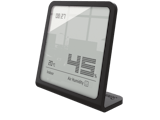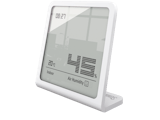
Nadine Walder, 7 February 2023
Dehumidify the air
How economical heating can lead to the formation of mould
Winter 2022/23 has presented us with a whole new set of challenges. A lot of people want to save on the electricity they use due to rising energy costs and one way to do that is economical heating. However, a lower room temperature has a direct impact on the relative humidity; and this can lead to undesirable side effects. In this article, you will find out all about the connections between turning down the heating and humidity.
The downside of energy-saving: economical heating can lead to humidity problems
At the moment, there is a lot of talk in the newspapers and on the radio about more cases of mould being reported this winter. One reason for this is people trying to save on energy costs by not turning their heating on as much. There is a downside to this saving: not having the heating on enough can actually lead to the formation of mould. A reduction in room temperature will lead to an increase in the relative humidity which can result in humidity problems such as the formation of condensation on windows or mould.
Why not having the heating on enough can lead to the formation of mould
Take a look at our video slideshow below or read on to find out all the details about the connection between lower room temperature and the increase in humidity.
The ideal humidity indoors is 40-60%. If the relative humidity is constantly too high, it can lead to humidity problems such as the formation of mould. You might be wondering what that has got to do with economical heating. The main reason lies in the interaction between temperature and relative humidity. Cold air cannot absorb as much humidity as warm air as explained in the graphic below.
At 22 degrees Celsius, the relative humidity is 51.5%. Just by reducing the temperature to 20 °C, the relative humidity will increase to 57.9 % with the same amount of water in the air. Reducing the room temperature will therefore automatically lead to an increase in the relative humidity.
Practical tips: correct heating and ventilation to prevent mould
If you want to be more economical with your heating on account of the rising energy prices, there are a number of points that you should take into account to make sure that you avoid humidity problems or even mould:
- Keep an eye on the relative humidity: With a hygrometer you can see how high the humidity is within your home at any time. Purchasing a hygrometer is an extremely wise and cost-effective investment.
- Ventilate your home regularly: How you ventilate your home has a decisive influence on humidity. You should carry out intensive ventilation regularly. When you open your windows, it lets cold air in which comes into contact with the warm air, reducing the humidity automatically.
- Avoid creating too much steam: When you are cooking, steam is produced very quickly and it can make the windows in your kitchen steam up which also promotes the formation of mould. So when you are cooking, make sure that the room is not filled with steam by putting lids on pans and switching on your extractor fan if you have one.
- Keep your shower as cold and short as possible: While a hot shower may be tempting, it also promotes the development of excessively high humidity. In any case, you should ventilate your bathroom immediately after showering to let the steam escape outside. Or even better: take a quick cold shower. Not only is it good for the humidity, it will also save on energy costs at the same time.
- Use a dehumidifier: A dehumidifier removes the moisture from the air and ensures ideal relative humidity. A hygrostat ensures that the device switches off automatically when the desired level of humidity is reached. If the relative humidity goes above the target value set again, the dehumidifier will switch on automatically so it will never get too humid indoors. Purchasing a dehumidifier is generally a worthwhile investment. You can use it in the summer too if the humidity indoors tends to rise or you can put it in the utility room to make your washing dry quicker.
If you have questions related to indoor room climate, please get in touch with us. Or subscribe to our newsletter to regularly get informed about current topics regarding indoor climate, experience reports or Stadler Form insights.






